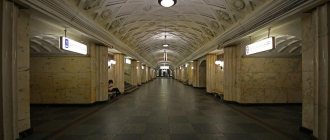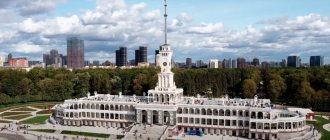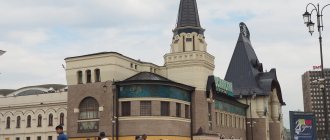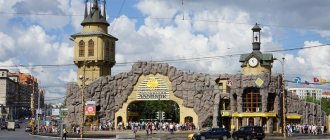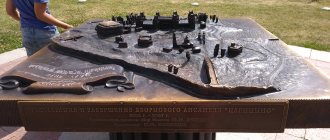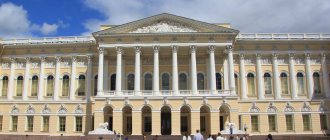Old Arbat is one of the main attractions of Moscow, a very popular pedestrian street with many souvenir shops, cafes and shops.
The history of Arbat goes back more than five centuries - since the 16th century, blacksmiths and artisans settled here, and under Ivan the Terrible a vast Streltsy settlement appeared. In 1736, as a result of another particularly strong fire, most of the wooden buildings that existed at that time burned out, and stone mansions of the most notable noble families began to appear on Arbat - the Golitsyns, Sheremetyevs, Tolstoys, Gagarins.
Since the end of the 19th century, the appearance of the street changed again - merchants and intelligentsia replaced the aristocrats, apartment buildings, shops, fashion stores, and restaurants appeared.
Soviet times also left their mark in the form of the destruction of most churches, the construction of new and reconstruction of existing buildings in the constructivist style, and communal apartments appeared instead of spacious apartments. In Stalin's times, Arbat Street was made a government highway along which the leader of the people passed to the Kremlin.
The length of the street is only 1.2 kilometers, it starts from Arbat Gate Square (Arbatskaya metro station) and ends at the Garden Ring on Smolenskaya-Sennaya Square (Smolenskaya metro station).
So, let's start our walk from the corner house No. 2 - the famous Prague restaurant.
“Prague” was opened at the end of the 19th century by the merchant Tararykin. Having won an apartment building with a tavern in a game of billiards, the resourceful merchant turned it into a first-class restaurant where A.P. visited. Chekhov, L.N. Tolstoy, I.E. Repin.
The restaurant's signature Culinary still sells Bird's Milk, Prague, Wenceslas, and Leningradsky cakes; you can buy duck pate, loose herring butter and beetroot cutlets. In Soviet times, cakes from this culinary industry were very much appreciated; people came from all over Moscow to buy them. Here, in 1978, the legendary “Bird's Milk” first appeared on sale, which was invented by Prague confectioner Vladimir Mikhailovich Guralnik.
The paving stones and lanterns were made in 1986 after reconstruction, as a result of which Old Arbat became pedestrian.
Most of the buildings on Old Arbat are former apartment buildings, the apartments in which were rented out. Here are some examples of such houses:
No. 9 – apartment building built in 1873-74 by O.S. Burgardt-Gvozdetsky. At the end of the 19th - beginning of the 20th century, there was a bakery D.I. Filippov, and in the 1920s - the Arbatsky Podvalchik cafe, where Vladimir Mayakovsky, Alexander Blok, Sergei Yesenin, Isadora Duncan, Andrei Bely were regulars. Currently - Ukrainian Cultural Center in Moscow.
No. 11 with lion masks is an apartment building of a Moscow private pawnshop.
Ornate No. 12 – apartment building of the Orlovs.
Another interesting building is No. 35/5. The Filatov apartment building, which is often called the “House with Knights.” This is the tallest building on the street, with neo-Gothic elements and sculptures of sad knights. Before the revolution, it had luxurious interiors - stained glass windows, marble staircases, large apartments, and after - communal apartments.
Nowadays, it houses the Central House of Actors, offices and the jewelry store “Gems”, famous since Soviet times.
Directly opposite the “House with Knights” is the Vakhtangov Theater (house no. 26).
To the right of the main entrance, in 1997, in honor of the performance of the same name, the calling card of the Vakhtangov Theater, a fountain with a statue of Princess Turandot by A. Burganov was erected. In 2001, the statue had to be restored - it attracted precious metal hunters, who sawed off the princess’s hand and part of her dress.
Let's go a little further. Another remarkable place is the wall of house No. 37, which fans of Viktor Tsoi’s work turned into a place of memory of the singer in 1990.
Relatively recently - on March 8, 2002, not far from house No. 43, in which Bulat Okudzhava lived, a sculptural composition was unveiled in his honor.
Another new monument is the sculpture “Pushkin and Natalie,” erected for the 200th anniversary of the poet’s birth.
The sculpture stands in front of the two-story blue mansion No. 53, in which Pushkin and Natalya lived in the first months after their wedding. Now there is a museum here - Memorial Apartment of A.S. Pushkin on Arbat.
The indispensable attributes of Old Arbat are street musicians and artists.
After perestroika, Arbat became the main place for trading nesting dolls, painted eggs and earflaps.
Now the souvenir trade is carried out inside shops, but artists continue to exhibit paintings in the open air.
Lately there have been a lot of barkers advertising tattoo parlors and life-size dolls offering to take pictures.
Traditional Hare Krishnas who have been performing here for more than 20 years.
Eating on Arbat is not a problem - there is a choice of both expensive and pretentious restaurants and quite affordable chain cafes: Varenichnaya, Shokoladnitsa, Mu-Mu and one of the first McDonald's in Moscow, operating since 1993.
Behind McDonald's, the street leads to Smolenskaya-Sennaya Square, on which the building of the Ministry of Foreign Affairs rises on the left.
On the right stands the building of the Smolensky grocery store, famous since Soviet times, built in the constructivist style. Now the grocery store is occupied by a supermarket.
Old Arbat, Arbatskaya metro station. Filevskaya line of the Moscow metro
- November 16, 2018
- Rezeda Zaripova
Tips for tourists
The Arbatsko-Pokrovskaya line consists of 22 stations. Its total length is 45.1 km, and the total travel time is 67 minutes. On metro maps it is designated number 3, but in order of opening it is second. This diametrical branch connects the central part of the city with the northwestern and eastern regions. Arbatsko-Pokrovskaya is the longest line of the Moscow metro.
The Arbatskaya metro station belongs to the considered Filyovskaya line of the Moscow metro.
The article presents one of the most popular streets in the capital - a favorite walking place for many city residents and guests of the capital. The main way to get to this place is by metro trains.
Comments (5)
Sergey
11/12/2015 at 12:07 pm |
There is NO OLD Arbat street in Moscow!!!Reply
Elena
03/04/2016 at 01:06 |
You forgot about the bookstores on Old Arbat! Moscow is a reading city, Muscovites and guests of the capital really liked to buy books on Arbat, it’s so important to bring culture and joy to people!!! And I don’t understand who could be bothered by books - this is the calmest type of trade, noble and necessary, but for some reason it is destroyed along with shawarma and all kinds of consumer goods.
Reply
Marianne
06/12/2016 at 08:21 |
Thank you!
Reply
Ksenia
10/24/2016 at 01:53 |
It’s a pity that you can’t sing and dance on the old Arbat, I would sing and dance))
Reply
Nikita
07/14/2017 at 02:44 |
They also forgot to talk about the illegal trade in corn, ice cream and other products of unknown origin. The main thing is that the police and government live in abundance, and no one cares about what they are doing to the residents and guests of the capital for a long time...
Reply
About the origin of the street name
How to get to Old Arbat? There are plenty of metro stations here. But first, let's look at the origin of the street name. There are several theories about the origin of this name. According to the main version, it is believed that it came from the Arabic word “robat”, meaning “suburb, suburb”.
In ancient times, carts were made in the vicinity of this area. It is possible that their name was taken from the word “arba”, which was used to describe a Mongolian two-wheeled cart.
The first attempt to rename this street Smolenskaya was made by Tsar A. M. Romanov, but local residents still called it in the old way - Arbat.
Street history
Arbat, also known as Old Arbat, is one of the most unusual streets in the capital of Russia. There is still no single version about where the name came from. Experts agree that the unusual name comes from the name of the area Orbat. Further, the opinions of linguists regarding the origin of this word, which is not typical for Russian speech, differ.
The following versions of the origin of the street name are common:
- from the Turkic word “arba” - there were workshops for making carts and carts nearby;
- from the Eastern word "rabad", meaning "suburb";
- other, less common variants are of Russian, Eastern and even African origin.
Orbat, Arbatskaya street was first mentioned in chronicles of the 15th century. Traditionally, artisans and traders settled in this area. After the invasion of Napoleon and the fire, which destroyed almost all the buildings, the Moscow aristocracy, the most notable Moscow nobility, began to settle on Arbat, and buildings were built in the Empire style. The nobles built houses, competing with each other in the originality of the facades.
But by the end of the 19th century, instead of the “cream of society,” commoners and representatives of the intelligentsia began to settle here. Noble one-story mansions began to supplant multi-story houses, and the street gradually took on a look close to its modern one. Retail trade boomed and many stores opened.
After the revolution, Arbat was thoroughly rebuilt, the mansions turned into communal apartments, and the government highway began to run along the pavement until the 50s of the last century, when it was moved to a new avenue. In the mid-70s, the process of creating a pedestrian zone began, which was completed by 1985. The street finally took on its modern appearance. Many cafes and shops with souvenirs have appeared here, and in the evening you can see performances by street performers and musicians. Guests of the city see this as a special flavor, but native Muscovites accept it without enthusiasm.
Today on this ancient street you can see a lot of interesting things:
- museums of great Russian writers;
- preserved architecture of various eras;
- Vakhtangov Theater, etc.
The history of New Arbat began in 1963 with the demolition of the Dog Playground. The appearance of the new highway was formed by 1968, and according to the plans of its creators, it became an integral ensemble - a fragment of the city. The image of the street is defined by a two-story shopping complex, above which rise high-rise administrative and residential buildings, including the famous “book houses.”
Story
Old Arbat has an amazing history (the nearby metro stations are presented later in the article). He is associated with famous government and cultural figures who lived and are living in this area. Following the terrible fire of 1736, the first wave of aristocracy came here. The street began to be populated by eminent noble families: the Golitsyns, Trubetskoys, Dolgorukys, Sheremetevs, Rostopchins, Kropotkins, etc. Arbat burned down again during the War of 1812.
Cars used to drive along this street in the 1930s. Joseph Stalin himself drove along it to his residence located in Kuntsevo. Related to this is the tragic story of the students who lived at that time in house No. 43. They were charged with attempting to shoot a party leader from their apartment. This was in 1944. The situation turned out to be absurd, since the windows of this room overlooked the courtyard of the house.
General information about Old Arbat
How to get to this street to see all its historical sites? First, let us present a short description of this wonderful holiday destination.
It took 12 years for Arbat to become a pedestrian zone. It starts from Arbat Gate Square and ends at Smolenskaya Square.
This is the most famous pedestrian street not only in Moscow, but throughout Russia. This is a symbolic street. She is sung in hundreds of novels and poems. Arbat is one of the oldest streets, where, despite numerous changes, it is quite possible to feel the spirit of past eras.
How to get there
Getting to Old Arbat is quite easy. Either by public transport or by taxi.
Metro to Arbat
The nearest metro stations are located next to Arbat and Smolenskaya-Sennaya squares. They correspond to the stations of the Moscow Metro - “Arbatskaya” of the Filyovskaya line (blue line) and “Smolenskaya” of the Arbatsko-Pokrovskaya line (dark blue line). The most convenient way to get to the branches is from the Circle Line. The journey from the center by metro takes 5–7 minutes.
Scheme of the Moscow Metro - Yandex. Metro
Buses
Since Arbat is a pedestrian street, ground transport stops are located at its two ends.
Stop "Arbatskaya Square":
- No. 15 (route VDNKh (southern) - VDNKh (southern));
- No. A (route Metro “University” - Metro “University”).
Stop "Arbat Gate":
- No. m27 (route Karacharovsky overpass - Metro "Park Pobedy");
- No. m2 (route Rizhsky Station - Fili);
- No. H2 (route Belovezhskaya street - Belovezhskaya street).
Stop "Smolenskaya Square":
- No. T10, T79 (route Metro “Nagatinskaya” - Metro “Nagatinskaya”);
- No. T39 (route Fili - Fili);
- No. 64 (route Novodevichy Convent - Novodevichy Convent);
- No. B (“Luzhniki”) (route Novy Arbat Street - Luzhniki Stadium);
- No. C12 (route Luzhniki Stadium (south) - Luzhniki Stadium).
Public transport routes in Moscow - Mosgortrans
Attractions
Where Old Arbat is located, there are many interesting historical and cultural sites. Incredibly beautiful ancient buildings have their own history, none of which are similar to the other.
- The famous restaurant "Prague". Arbat begins with it. Previously, the building was an apartment building for the Firsanovs. During the 17th century it was rebuilt several times, and only in 1872 a tavern of the same name appeared in it. Over the years, it has turned into a famous Moscow restaurant, familiar to many ordinary people since childhood, since it was here that the wonderful Prague cake was created.
“House with Knights”, a wall in memory of V. Tsoi, B. Okudzhava’s house, Pushkin’s museum-apartment and much more are historical objects located on the famous Old Arbat of Moscow. How to get there to see it all with your own eyes?
Filevskaya line of the Moscow metro
For many Muscovites, this metro line is their favorite. This is one of the most unusual branches. One part of it meanders along the old river bed, after which it appears in comfortable areas of the western part of the capital, the other leads to the kingdom of high-tech.
Today, the largest reconstruction of its ground part in the history of the line continues. At the stations, which were built according to construction standards of the mid-20th century, load-bearing structures that have served for 60 years are being replaced. The lobbies and platforms are completely rebuilt and expanded. Thus, the Filevskaya line takes on a modern look and will serve Muscovites for many years to come.
How to get there by metro?
Old Arbat is a fairly long street. Before going there, you should figure out where you want to go, which part of the street. To arrive at the end of the pedestrian street, it is more convenient to go to the Smolenskaya station. If you take the beginning of the Arbat as the starting point of the walk, it is more convenient to get to the Arbatskaya station by either of the two lines.
And from VDNKh it’s easy to get to Old Arbat. How to get there by metro? To do this, you should drive from the VDNKh station to Turgenevskaya, where you need to make the transition to the Chistye Prudy station. From it you should drive 3 stops to the “Library named after. Lenina" and go to the "Alexandrovsky Sad" station of the Filevskaya line and then drive to the "Arbatskaya" station (1 stop) or to the "Smolenskaya" station (two stops). You can also go to the Arbatskaya line of the Arbatsko-Pokrovskaya line and walk to Old Arbat.
How to get from three stations to Old Arbat? Komsomolskaya metro station is the starting point of this path. You should land at a radial metro station and after 5 stops get off at the Biblioteka im. Lenin". From here you can either walk to Arbat, or go to Arbatskaya and get out to the Khudozhestvenny Theater station. You can also travel from the Arbatskaya station one stop to the Smolenskaya station, from where you can exit to Smolenskaya Square, located at the end of the pedestrian street. From this place it is not far to walk to the theater. Vakhtangov and the monument to B. Okudzhava.
It’s easy to come from the Kuntsevo area. From the Kuntsevskaya station, take the Filevskaya line to Smolenskaya or Arbatskaya and exit to the required part of the street. If the train travels on the Arbatsko-Pokrovskaya line, you need to get off at the Arbatskaya metro station, located on the blue metro line. The fact is that the Filevskaya blue line and the Arbatsko-Pokrovskaya blue line have stations with the same names. From them there is access to the beginning of the Old Arbat, as well as to Smolenskaya Square, where the pedestrian street ends.
How to get to Old Arbat by metro
The easiest way is to get off at the Arbatskaya metro station from the Arbat Gate. A station with this name exists on both the Filevskaya and Arbatsko-Pokrovskaya lines of the Moscow Metro. In this way, you can get to the conditional “beginning” of the desired street - the numbering of houses begins on this side.
Other ways to get to Old Arbat in Moscow:
- bus routes M2, M27,39, H2 – to the stop “Arbat Gate Square”;
- bus 39A, 15 – “Arbat Gate”.
The conventional “end” of the street reaches the Smolenskaya metro station.
Important! This popular street was officially called Smolenskaya for some time, but the name did not stick.
Arbatskaya station
One of the closest to Old Arbat is the Arbatskaya metro station. Its depth is 41 meters. It was opened in April 1953. Today it has three connections to the following stations: “Alexandrovsky Sad” (Filevskaya line), “Biblioteka im. Lenina" (Sokolnicheskaya line) and "Borovitskaya" (Serpukhovsko-Timiryazevskaya line). The very beautiful Arbatskaya station has deservedly received the status of a cultural heritage site.
It was built according to a special project. The length of the hall is 220 meters (second in size after Sparrow Hills). The shape of the central hall is an ellipse. The architects who created the station project applied the theme of Russian architecture (style - Moscow Baroque).
The pylons in the lower part are decorated with red marble. Ceramic decorative elements with picturesque plant motifs are installed on the walls. Similar compositions are used to decorate track walls. The floors are decorated with carpet patterns of black, red and gray marble. The platforms and central hall are illuminated by gilded luxurious chandeliers.
What other stations are under reconstruction?
In October last year, three stations of the Kakhovskaya metro line were closed - Kashirskaya, Varshavskaya and Kakhovskaya. After repairs, they will be included in the Big Circle Line (BCL). The Kakhovskaya station should open in 2021, and the Varshavskaya and Kashirskaya stations, along with the eastern section of the BCL, should open in 2022.
During the line's closure, passengers can use the Kashirskaya stations of the Zamoskvoretskaya line and the Sevastopolskaya stations of the Serpukhovsko-Timiryazevskaya metro line. In addition, for convenience, seven free routes have been launched that connect closed stations. The operating hours of compensation buses are from 5:30 to 2:00, the interval during rush hour is 6-7 minutes. Regular ground transport routes are also maintained between the closed stations of the Kakhovskaya Line: trolleybuses No. 60, 72, 40 and buses No. 607 and 908.
Photo: mosmetro.ru
And at the Savelovskaya station, part of the underground passage is closed for repairs from February 1 to September 1, 2021. Exits No. 3, 4 and 5 to Skladochnaya Street, to the Savelovsky shopping complex and to Novoslobodskaya Street are closed for citizens. To get from the metro or from the train, for example, to the Savelovsky shopping center, you need to go to the Savyolovsky station square and go towards the Savelovskaya overpass, and take the first left on it. The journey takes about 10 minutes. There are signs along the entire bypass route.
In addition, from February 22 to 24, the lobby of the Ploshchad Ilyich metro station on the Kalininskaya line will be inaccessible to passengers. To enter and exit, you can use the Rimskaya station of the Lyublinsko-Dmitrovsky line. The Ploshchad Ilyich station will operate as usual on the morning of February 25.
Where is Old Arbat located? — street on the city map
Old Arbat (or simply Arbat) is located in the center of Moscow
, to the west of the Kremlin, starting at Gogolevsky Boulevard and ending at the Garden Ring. On the old Arbat there are numerous architectural monuments and museums, including the house where Pushkin stayed. Old Arbat has been a pedestrian zone since Soviet times.
You can walk to Old Arbat to the Arbatskaya or Smolenskaya metro stations, which are located, respectively, at the beginning and end of Old Arbat.
Old Arbat
is in the lists: streets, Moscow
Share the link “Where is Old Arbat?” with friends:
Strastnoy Boulevard
Strastnoy Boulevard is located in the center of Moscow and is part of the Boulevard Ring. It is located between Tverskoye.
Sakharov Avenue
Academician Sakharov Avenue is located in the center of Moscow and runs from Turgenevskaya Square to the northeast, crossing.
Champs Elysees
The Champs Elysees is located in the center of Paris. The Avenue des Champs-Élysées stretches from the Place de la Concorde to the Place de la Triomphe.
Millionnaya Street
Millionnaya Street is located in the center of St. Petersburg and runs parallel to the Bolshaya Neva from the Field of Mars to.
Red Avenue
Krasny Prospekt is located in the center of Novosibirsk and runs through this center from the very junction at the bus station.
«

